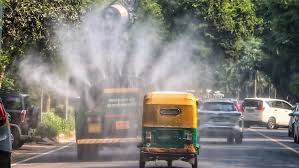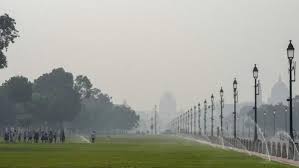Newspapers of the recent past reveal that air pollution has escalated to dangerous levels in the national capital region. The CPCB rating it as “Severe” at times. Many people wake up in the morning to find that the cities are covered by a dense smoke. Ordinary AQI results range above 500 in many regions. This decline is not just a seasonal occurrence; it is worsened by motor vehicle. Exhaust emissions, industrial effluptions, construction dust, and agricultural straw burning in adjacent regions..

The Current Situation
Poor air quality issues have a very debilitating impact on health. Some have established a link between poor air quality and all causes. Of morbidity and mortality, chiefly respiratory ailments and cardiovascular disorders. The groups more at risk especially during flu season are the children, the elderly and those with other underlying illness. Asthma, bronchitis, and other respiratory illness are usually observed to show increased hospitalization rates during the most polluted months which puts additional pressure on an already stretched health care system.
Health Impacts
Air pollution is listed by WHO as one of the environment’s. Biggest risks to health and it is estimated to be killing millions. This is especially so in Delhi, which has some of the worst air quality globally. Meaning the risks are much higher. There are concerns of chronic health implications of long-term effects of this pollution Lifetime pollution. Effects are likely to be negative and pounds alarms over the future wellbeing of the city.
The social cost of pollution is also not far behind the effects within the environment. The pollutants and gases do impact human health as well as the acceleration of degradation of ecosystems. Acid rain due to pollutants damages the land and water resources which gives a bad impact on farming, etc., wildlife. Contamination of particulate matter in cities is a cause of climate change which in turn. Continues to threaten human life and species’ survival.

Environmental Consequences
The costs that pollution takes on the environment are just as worrisome. However, the quality of air in the region is toxic in as much. As it does harm human health as well as aggravate the natural environment. Pollutants cause ‘acid rain’ that impacts the quality of soil and water resources in effecting agricultural production and wildlife. The deposition of particulate matter in urban centres actually contribute to climate change, and so the problem continues to worsen other above highlighting the risk it poses to the health of the citizens and also the creatures in the ecosystem.
Government Response
Over the years, to curb the crisis the Delhi government has enacted many measures which include the Odd-Even. Vehicle scheme, more green coverage areas, banning construction and many industries. However these initiatives have been criticized in many way most of the time due to poor implementation and merely short-term focused programs.
Activists say that a better approach should be employed, one that prevents pollution rather than seeking to mitigate it. This include increasing affordability and accessibility of public transport, encouraging use of efficient technologies, and optimising physical design to decrease traffic flow.
Community Action
At community level, there has been increased action too as governments set up programs to make this into a reality. People in local societies and organizations are paying much attention to air pollution complaining, raising awareness, and applying pressure to gain improvements. New ideas include using air cleansing plants and even green walls as added effective air quality sampling by citizens.

Looking Ahead
Now more than ever, leaders, communities and even companies require an approach to comprehensively address the issue in Delhi. Since air pollution is one of the biggest threats to the life and health of the population, the need for change has never been more important.
The coming months will be pivotal in determining the trajectory of air quality in Delhi. Without concerted efforts, the toxic air that plagues the city will remain a significant challenge, demanding both immediate action and long-term commitment to safeguard the health of its residents and the environment. As the haze descends once more, the city holds its breath, hoping for clearer skies ahead.
Conclusion
Evaluating the results, the experience of Delhi in coping with air pollution acts as a reminder that immediate systemic coordinated actions are needed. While waiting for the onset of winter, which historically marks the worst air quality in the city, millions of people’s health are at stake. Everyone starts with the government, communities, and citizens themselves for practical solutions to reduce the root cause of pollution.
Frequently Asked Question (FAQS)
1. What are the main causes of air pollution in Delhi?
The main sources are vehicular exhausts, industrial effluons, construction dust, and burnt agricultural stumps from neighbor states. A social construction of weather also influences the growth of pollutants in the environment especially during the specific seasons.
2. How is air quality measured in Delhi?
They are vehicle emissions, industrial effluent discharge, construction dust as well as agricultural casing of stubbles which occur in other states. It is also the right time to note that in different seasons, the weather also plays a great part in the formation of pollutants.
3. What are the health effects of air pollution?
The Delhi government has put in place policies like banning of old vehicles, the odd-even car policy, renewed construction norms, and environmental conservation policies, and increase green coverage. But, they have been criticized on the basis of their efficiency.
4. What steps has the government taken to combat air pollution?
The Delhi government has put in place policies like banning of old vehicles, the odd-even car policy, renewed construction norms, and environmental conservation policies, and increase green coverage. But, they have been criticized on the basis of their efficiency.
5. How can individuals help reduce air pollution?
People can help by taking the bus, sharing a ride, turning off light, offering to help with local efforts that drive environmental change on air quality. Education and campaigning on the appropriateness of cleaner practices are also important Too.